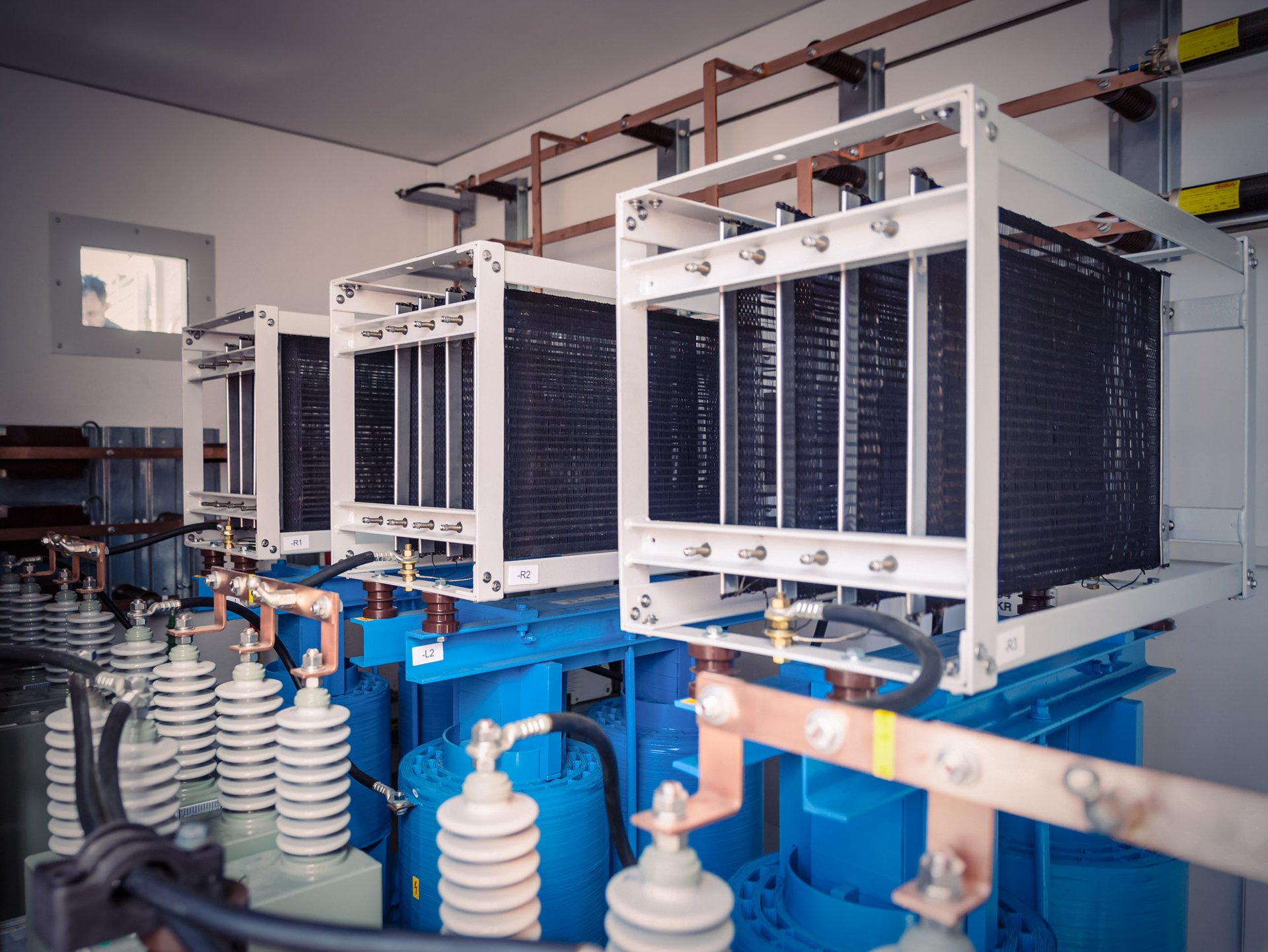A soft breeze is wafting across the fields of the Palatine municipality of Offenbach an der Queich. It sets the huge rotor blades of the six wind turbines operated by regional energy supplier EnergieSüdpfalz GmbH & Co KG into motion. Each year, they produce a total of 40 million kilowatt-hours for 13,800 households. The wind farm has a total output of 15.8 megawatts. A small concrete structure turns it into something special: The little building contains the first high-frequency filter system from MR, which ensures disruption-free grids at frequencies up to 9 kHz.
-
Impulses
- Impulses overview
-
Transformer manufacturers
- South America's champions of the energy transition
- Traction Transformers – Future on the Rail
- Time of the giants: XXL transformers for more power
- "Reinhausen is ready to deliver!"
- Oversized de-energized tap-changers
- The most powerful transformers in the world for a 1,100 kV HVDC line in China
- "We are in a growth market with the VRDT"
- Digitalization turnaround: GANZ Intelligent Solutions relies on cooperation with MR
- "Transitioning to a solution provider presents a major opportunity for transformer manufacturers – and digitalization can help!"
-
Digitalization
- How AI can lend a hand
- myReinhausen: MR's central digital customer platform
- Why data centers (may) never fail
- Automation? (Cyber-) Secure!
- Globally unique: MESSKO® MTRAB® dehydrating breather communicates via cell phone app
- Remote Solutions: Professional help from a distance
- "Digitalization of the power grids will only work with comprehensive security measures"
- Why are you digitizing your transformers? Three questions for Rúnar Svavar Svavarsson.
- Six challenges, six solutions – Intelligent sensors for safe transformers
-
Energy transition
- The VRDT is the ideal solution to solve voltage problems in our distribution grids
- Making transformers more sustainable
- 940 tons of power regulation
- Sunny prospects: Municipal solar storage devices
- Four reasons why regulated distribution grids are the future
- "The energy transition is taking place in the distribution grids"
- Five theses on the future of power grids
- Storage at all network levels
- Test systems for the energy revolution
- Climate change, energy revolution and the future of power grids?
- A new design for utility poles
-
Wind and solar power
- The North Sea as Europe's green power plant
- Sahara electricity - safe for the island
- Are wind farms the new power plants?
- Direct current at all grid levels
- The MSCDN plant – the new "power plant generator" for stable grids
- Clean power grid with high-frequency filters
- Weatherproof cable testing for offshore wind parks
- VRDTs for Australia's distribution grids
- Lifetime optimization
- Power supply in industry
- Globalization
- Impulses overview
-
Transformer manufacturers
- South America's champions of the energy transition
- Traction Transformers – Future on the Rail
- Time of the giants: XXL transformers for more power
- "Reinhausen is ready to deliver!"
- Oversized de-energized tap-changers
- The most powerful transformers in the world for a 1,100 kV HVDC line in China
- "We are in a growth market with the VRDT"
- Digitalization turnaround: GANZ Intelligent Solutions relies on cooperation with MR
- "Transitioning to a solution provider presents a major opportunity for transformer manufacturers – and digitalization can help!"
-
Digitalization
- How AI can lend a hand
- myReinhausen: MR's central digital customer platform
- Why data centers (may) never fail
- Automation? (Cyber-) Secure!
- Globally unique: MESSKO® MTRAB® dehydrating breather communicates via cell phone app
- Remote Solutions: Professional help from a distance
- "Digitalization of the power grids will only work with comprehensive security measures"
- Why are you digitizing your transformers? Three questions for Rúnar Svavar Svavarsson.
- Six challenges, six solutions – Intelligent sensors for safe transformers
-
Energy transition
- The VRDT is the ideal solution to solve voltage problems in our distribution grids
- Making transformers more sustainable
- 940 tons of power regulation
- Sunny prospects: Municipal solar storage devices
- Four reasons why regulated distribution grids are the future
- "The energy transition is taking place in the distribution grids"
- Five theses on the future of power grids
- Storage at all network levels
- Test systems for the energy revolution
- Climate change, energy revolution and the future of power grids?
- A new design for utility poles
-
Wind and solar power
- The North Sea as Europe's green power plant
- Sahara electricity - safe for the island
- Are wind farms the new power plants?
- Direct current at all grid levels
- The MSCDN plant – the new "power plant generator" for stable grids
- Clean power grid with high-frequency filters
- Weatherproof cable testing for offshore wind parks
- VRDTs for Australia's distribution grids
-
Lifetime optimization
-
Power supply in industry
-
Globalization
Impulses - Portfolio
-
Career
Career
-
Company
Company
Clean power grid with high-frequency filters
Wind turbines supply environmentally friendly energy. But it can place a strain on electricity grids. At a wind farm in Germany's Rhineland-Palatinate region, a high-frequency filter system from MR keeps the grid in perfect working order.
Clean power grid with high-frequency filters
Wind turbines supply environmentally friendly energy. But it can place a strain on electricity grids. At a wind farm in Germany's Rhineland-Palatinate region, a high-frequency filter system from MR keeps the grid in perfect working order.
Stable grid frequency
This is necessary because, although power from renewable energy sources is environmentally friendly, it is difficult to keep the grid frequency in wind power plants at a stable level in contrast to conventional power stations. The rotors turn faster or slower depending on the strength of the wind. The amount of energy generated varies. In order to balance out these fluctuations, rectifier transformers with what are known as IGBTs (insulated gate bipolar transistors) are brought into play in modern wind power plants. The problem here, however, is that this technology causes harmonics that can be damaging to electricity grids. A wind farm operator is therefore only allowed to supply its power to the grid provided that certain limit values are not exceeded.
This was exactly the problem that EnergieSüdpfalz and project developer juwi Wind GmbH were faced with. The electricity generated by the wind turbines exceeded the limit values for harmonics at frequencies of up to 9 kHz. That being the case, the two partners turned to the Power Quality experts at MR for advice. “Harmonics are not unusual per se and can be dealt with using passive filter systems. We already have many years of experience in this field. But normally we would be dealing with frequency ranges up to 2.5 kHz,” explains Dr. Thomas Schlegel, Head of Engineering in the Power Quality department.

„Filtering out harmonics sufficiently in the high frequency range was also crucial.“
Dr. Thomas Schlegel, Technical Manager of the Power Quality department
Three filter circuits fight harmonics
Schlegel and his team took on the challenge and got started on the development of a suitable filter concept. The aim was to drop the harmonic level in the frequency range of up to 9 kHz over a broad spectrum, significantly reducing individual harmonic frequencies in the process. The experts started by taking comprehensive measurements at the wind farm before combining them with a mathematical simulation. “We can only come to a optimal solution if we link our models to real measured values,” states Schlegel. A passive harmonic filter system is always made up of the same components. These include reactors, capacitors, circuit breakers, and voltage transformers.
“The key was to match these components with each other so that they would actually filter out the harmonics to a sufficient degree in the high-frequency range. In the end, every filter circuit system is different, as it is always precisely tailored to the conditions on site. The grid structure plays a role here – but so too do many other parameters.” The solution turned out to be a concept involving three filter circuits with tuning frequencies of 189/3,800/5,600 Hz and a total output of 2,800 kvar. The Power Quality experts also completed the installation on site. “We aim to provide our customers with integrated solution concepts. That is why we oversaw the project from the initial concept all the way through to commissioning,” says Schlegel. Conformity tests confirmed the performance of the system in operation. As a result, 13,800 households have been receiving clean electricity from clean wind power since April 2017.
households receiving clean energy thanks to the system.
kHz Up to this frequency range, the grids remain interruption-free.
kvar Total power generated by the system.
At a glance
- When generating power from wind, harmonic currents often occur which disrupt the power quality within the grid.
- If wind turbines frequently exceed the prescribed limit values, they have to be removed from the grid or they may even lose their operating license.
- The high-frequency filter system from MR ensures disruption-free grids at frequencies of up to nine kilohertz. Until recently, this was only possible at frequencies of up to 2.5 kilohertz.
- This is based on a concept involving three filter circuits with tuning frequencies of 189/3,800/5,600 Hz and a total output of 2,800 kvar.

We are here for you. Wherever you are.
Looking for the right contact partner?
Do you have a concern, but don't know whom you should contact? You will find that information in our contact overview. In the event of any technical disturbances, our 24/7 support is always at your disposal.
Welcome to myReinhausen
myReinhausen is MR's central, digital customer platform. On myReinhausen, customers can access customer-specific MR information as well as numerous free features related to the MR portfolio.
myReinhausenJoin Reinhausen family
Find your ideal job quickly!
Check our vacancies here. Apply today and contribute at the world market leader in energy technology keeping the energy supply stable in the future.

